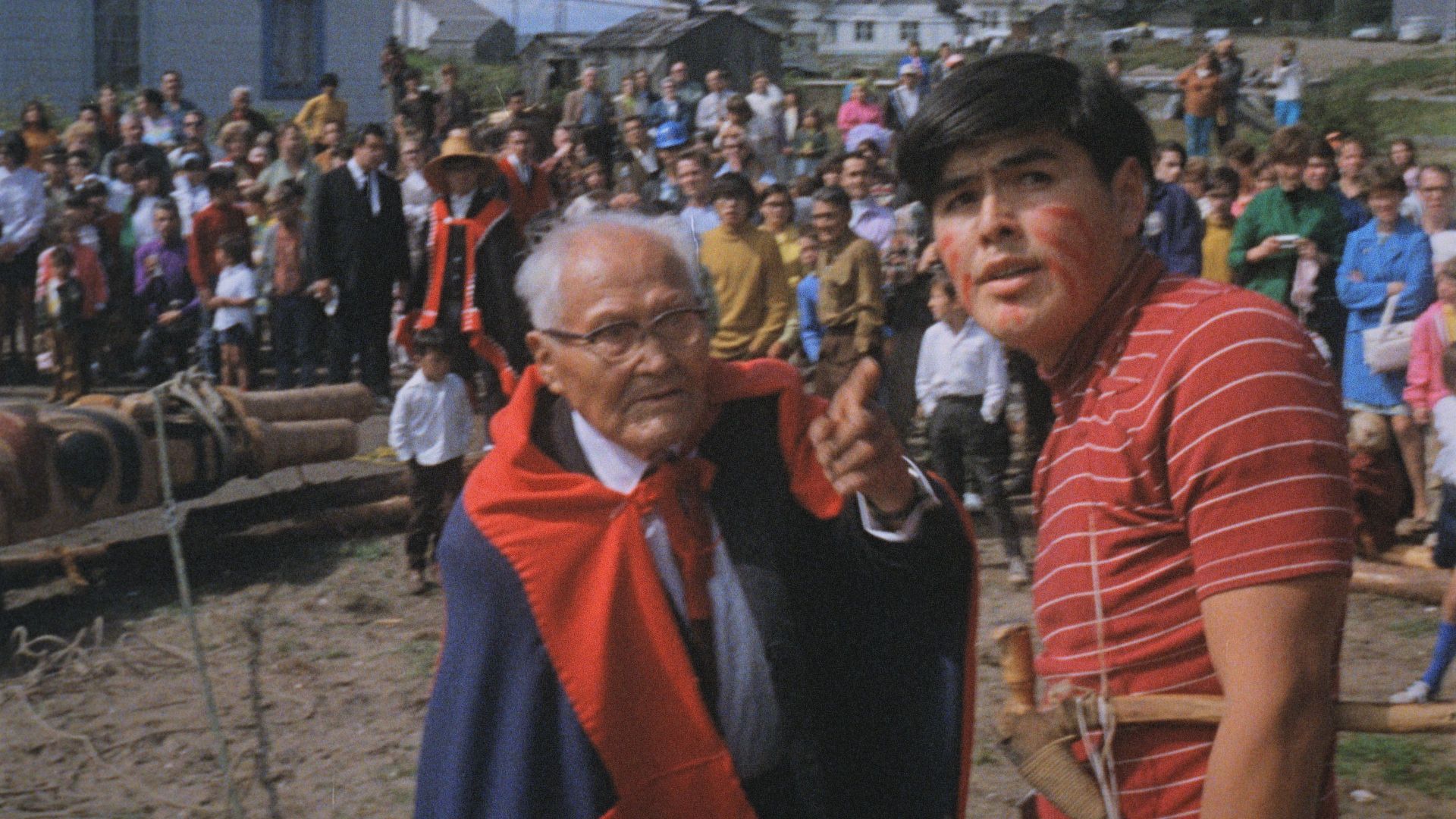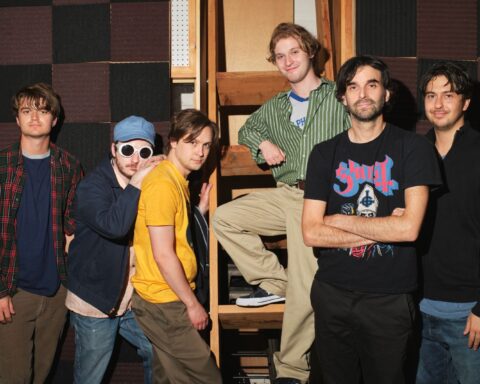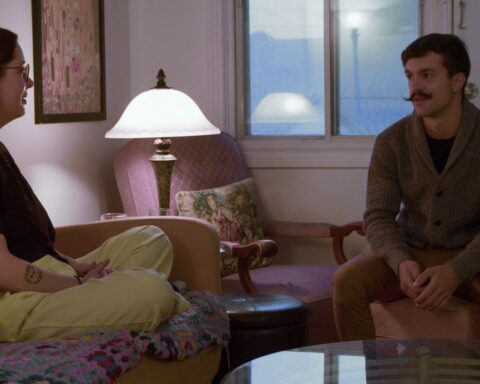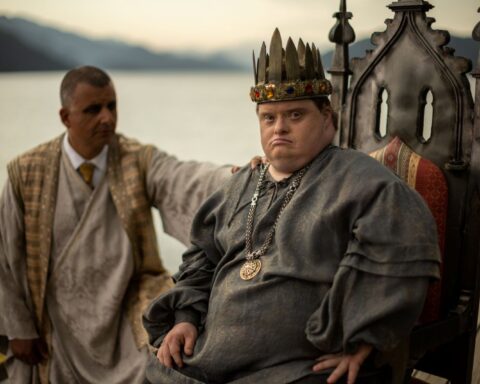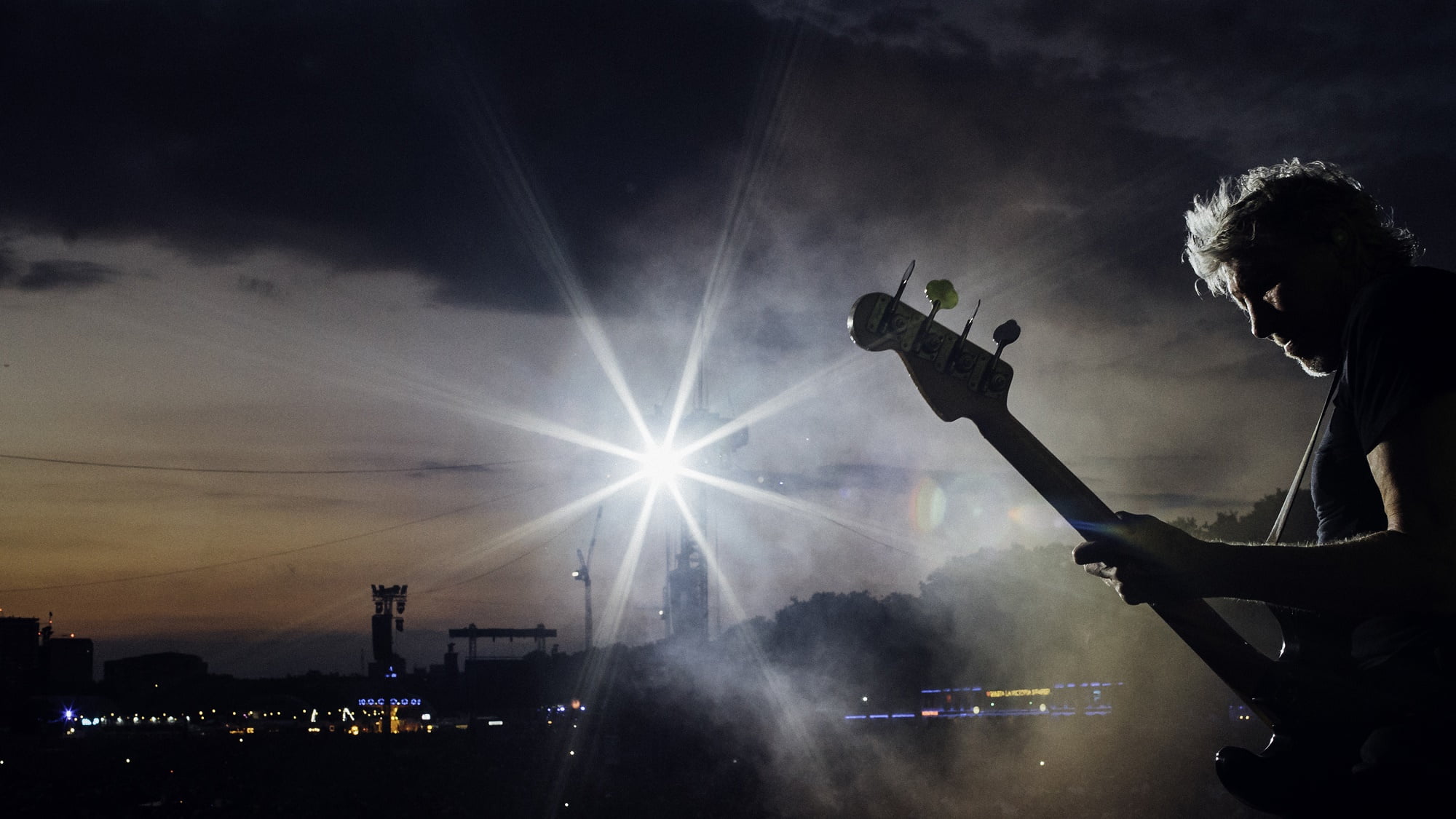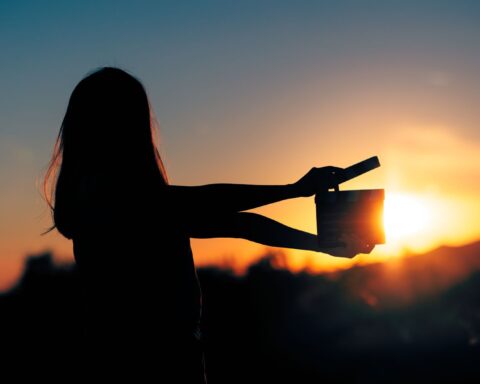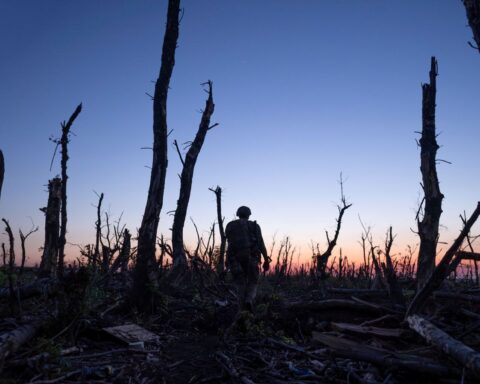Now is the time for artists like Christopher Auchter. The Haida filmmaker revisits a slice of NFB history and a seminal event in his community’s history with his new documentary Now Is the Time. The film resurrects, restores, and reframes images shot in 1969 that captured Robert Davidson carving the first totem pole that the community of Old Massett had raised in nearly a century.
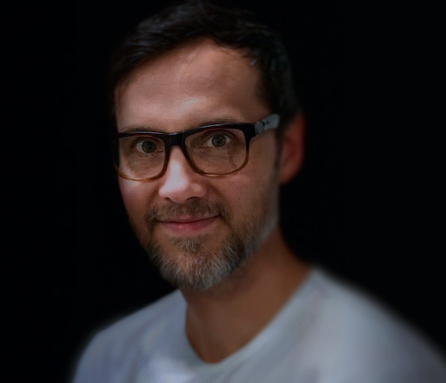
These images, featured in Eugene Boyko’s 1970 NFB film This Was the Time, find new life in the Board’s ongoing effort to correct the past by inviting Indigenous filmmakers to experiment with the archives. Using a mix of animation and archival material alongside contemporary footage of Davidson, Now Is the Time both illustrates and contributes to the ongoing Indigenous renaissance in film and culture.
Auchter, speaking with POV at the NFB’s Toronto office during the Toronto International Film Festival where the film premiered earlier this month, says the process of diving into the original images and B-roll was a beautiful experience of connecting with his community. “I was so intrigued and captivated by seeing Massett and the people that were there 50 years ago in the place where I grew up,” says Auchter.
The totem carving and ensuring ceremony is especially important for Auchter in documenting the Haida community because potlatches became illegal in 1884. Although the Canadian government repealed the ban in 1951, potlaches remained rare and were major targets for assimilation practices. Davidson’s act was one of true resilience.
“I grew up surrounded by Haida art, designs, and singing at big events,” observes Auchter, “but when you listen to Robert speak, that wasn’t how he grew up. It was very different.” For a filmmaker born just a few years after Robert’s feat with the totem pole, there’s a vast void of experiences to consider, as well as see which touchstones helped precipitate the renaissance of his culture.
Now Is The Time (Clip#1 – The old totem poles) from NFB/marketing on Vimeo.
“For me and in my research,” reflects Auchter, “my conclusion pointed to that event as a pivotal moment for bringing back our artistic culture. The singing, the dancing, the weaving, the costumes —all different aspects of the ceremony. I wanted to place the audience in that day, August 22nd, 1969.”
Auchter adds that seeing the images through the restoration process doubled his appreciation for the care taken that day. The film restores 35mm footage used originally in This Was the Time, as well as additional B-roll shot by the NFB’s “Indian Film Crew” and snippets from the CBC archives, some of which are 16mm but look seamless in Now Is the Time’s rejuvenation of the material. “When they digitized it into 4K, it just looked beautiful,” says Auchter. “Some of it looks like it was shot yesterday—only the clothing, the vehicles, and some of the styles give it away. It was beautiful to see the footage, but with the 4K you see extra details, like that little girl riding her bike.”
These are invaluable images of life in the Haida community at a time from which too few images and records exist, which makes the film’s documentation of the celebrated day in 1969 more relevant. The 1970 film, a well-intentioned product of its time, sees the totem carving and ceremony through a settler lens. Auchter’s framing of the footage, using Davidson’s reflections on the day in contemporary interviews, as well as conversations with Haida elders like scholar Barbara Wilson, sees the event through the eyes of the people who experienced it.
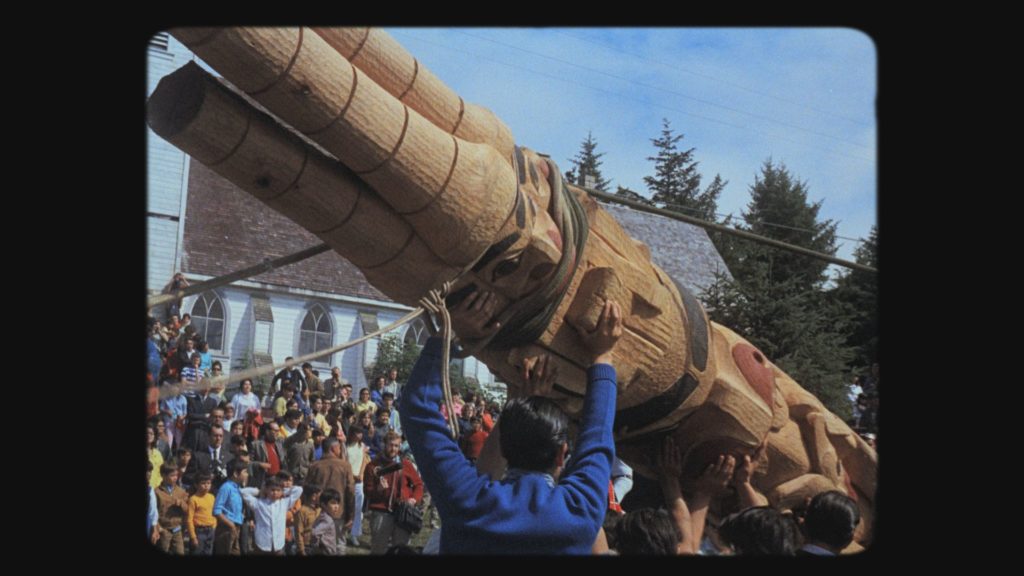
The filmmaker says he met Davidson once through his uncle at a potlatch many years before approaching him about the documentary. Auchter admits that getting to spend more time with Davidson and hearing his stories about the totem made the project a joy. “You could just see much that day still touches Robert,” says Auchter, noting Davidson’s anxiety over first approaching the log and the support he received from Haida elders. “You see how that part of our culture, the potlatches, stayed alive. They were showing up and there were no carvings, no headdresses. They just made it work with paper and cardboard.” The cardboard of the 1969 masks is more detectable to a discerning eye in Auchter’s film than in Boyko’s original, just one of the invaluable details afforded by the restoration—but one still has to do a double take to notice that they’re not meticulously carved woodwork.
In addition to the footage of the totem and the ceremony, Auchter’s film highlights Davidson’s craft by showcasing his striking hand-carved wooden masks. The masks, which are central to potlatch ceremonies and burned during the event, further display the endurance of Haida culture passed through the arts and crafts. “One primary focus was to place us in that time and to communicate just how far removed our art and culture was. It wasn’t happening,” explains Auchter on the interplay between the masks and the totem. “To see the beautiful carvings, the masks they didn’t have back then but are being carved now, was an important experience.”
Now Is the Time spotlights the masks in brief interludes dispersed throughout the film. The masks appear on black backdrops while revolving ever so slowly to allow viewers to appreciate their characteristics and details. Auchter says the inspiration for this aesthetic comes from the original footage from the CBC, which featured similar shots of masks displayed at the Indians of Canada Pavilion at Expo ’67 in Montreal. “They had all these Northwest Coast masks and I really loved how they shot it with dramatic lighting,” adds Auchter, noting how beautiful it was to see the masks highlighted in 1970s’-sytle rapid zooms.
The doc brings inanimate objects to life in many forms and draws upon Auchter’s background as an animator to create a unique hybrid film. For example, one sequence sees Davidson carving a small totem in his studio. As the chips fall onto the table and the wood begins to take shape, the totem springs to life and moves around with the magic of stop-motion animation, evoking the spiritual power of Davidson’s art. The artist interacts with his creation and blesses it with a playful wink. (The stop motion animation is by Alicia Eisen, whose short film Deady Freddy screens alongside Now Is the Time at VIFF’s Twists of Fate program.)
Now Is The Time (Clip#2 – The Haida language) from NFB/marketing on Vimeo.
Auchter, who studied animation at Emily Carr and Seneca and previously delivered the award-winning NFB film The Mountain of SG̲aana, says that the decision to infuse his first documentary with animation arose organically. The director explains that his first pre-interview with Davidson inspired the approach. “He mentioned the magic of the pole and the magic of the day in ’69,” says Auchter on meeting Davidson in the artist’s carving studio. “That inspired me to think about the magic of our art and the magic of animation. I wanted to bring our art to life.”
This magic also animates a drawing on Davidson’s wall through which the Haida spirit speaks in the imagery of an eagle and a raven. “In Haida culture, you’re either an eagle or a raven in terms of your clan,” explains Auchter. “Each clan has different crest as well, but the Haida spirit connects them.”
Auchter admits that wrestling with the character of the Haida spirit ultimately focused the project. “I wanted that character to give context,” says Auchter, “and I had pages written with so much information.” Auchter credits NFB producer Selwyn Jacob for encouraging him to distill the expository material into the spirit of the animation. “I heeded his advice and I took the essence of it,” adds Auchter. “That essence was to imagine our world without art. Now imagine if you were the one to help bring it back.” At a time when Haida art wasn’t visible, the film credits Davidson for restoring its place.
Now Is the Time contributes to this renaissance of Haida culture through art, much like Auchter’s The Mountain of SG̲anna and Gwaai Edenshaw and Helen Haig-Brown’s acclaimed dramatic feature Edge of the Knife, told in the Haida-language spoken fluently by a mere 20 people today. (A Haida version of Now Is the Time is also in the works.) Auchter says it’s inspiring to see these films and other aspects of Haida art reflect a deeper cultural renaissance.
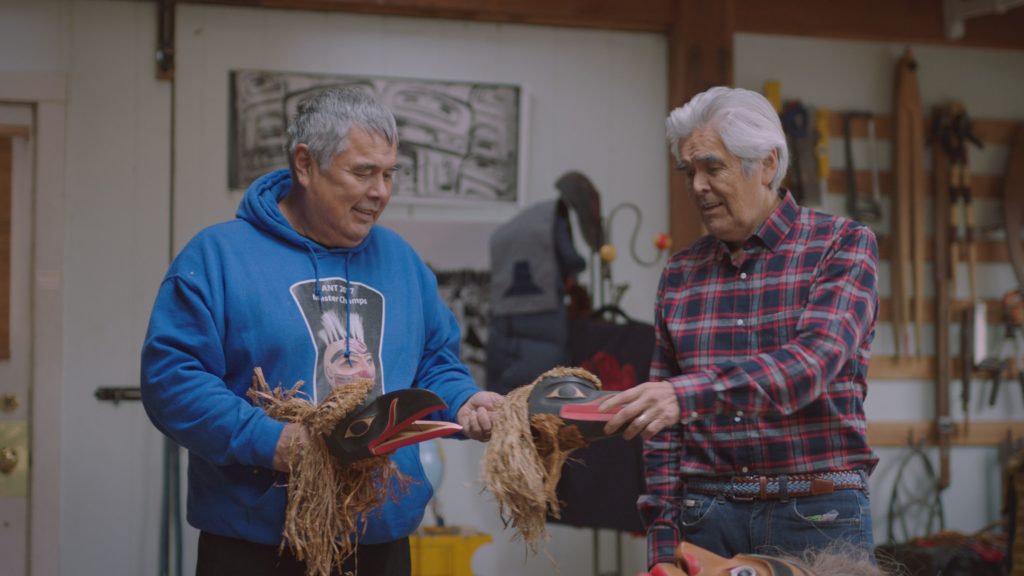
“There definitely is an interest with the youth learning our language,” reflects Auchter. “The elders make sure that the younger people know how to put on a potlatch and learn the songs and the dances of the ceremonies. Today, the elders and ones who speak Haida get together and gather in a room, like a big boardroom but in a beautiful Longhouse-style. They go there Monday to Friday and they record the language. There are immersion programs that partner elders with the youth, so an effort is there to keep culture alive.”
When asked how he feels the Canadian government is delivering on its promises for reconciliation, Auchter prefers not to talk politics, but to reflect on his personal experience with Now Is the Time. “I think this opportunity to do my first documentary with the National Film Board was a great part of that experience,” says Auchter. “I’ve been able to focus, learn this story, and do a deep dive into my Haida history. I’ve been able to learn the importance of totem poles and understand the ceremonies better.” As with Robert’s experience, it all begins with carving something new.
Visit the POV TIFF Hub and POV VIFF Hub for more coverage from this year’s festivals.
Now Is the Time premiered at TIFF and screens at VIFF on Oct. 3 and 10.
Now Is The Time (Clip#4 – Barbara Wilson) from NFB/marketing on Vimeo.




